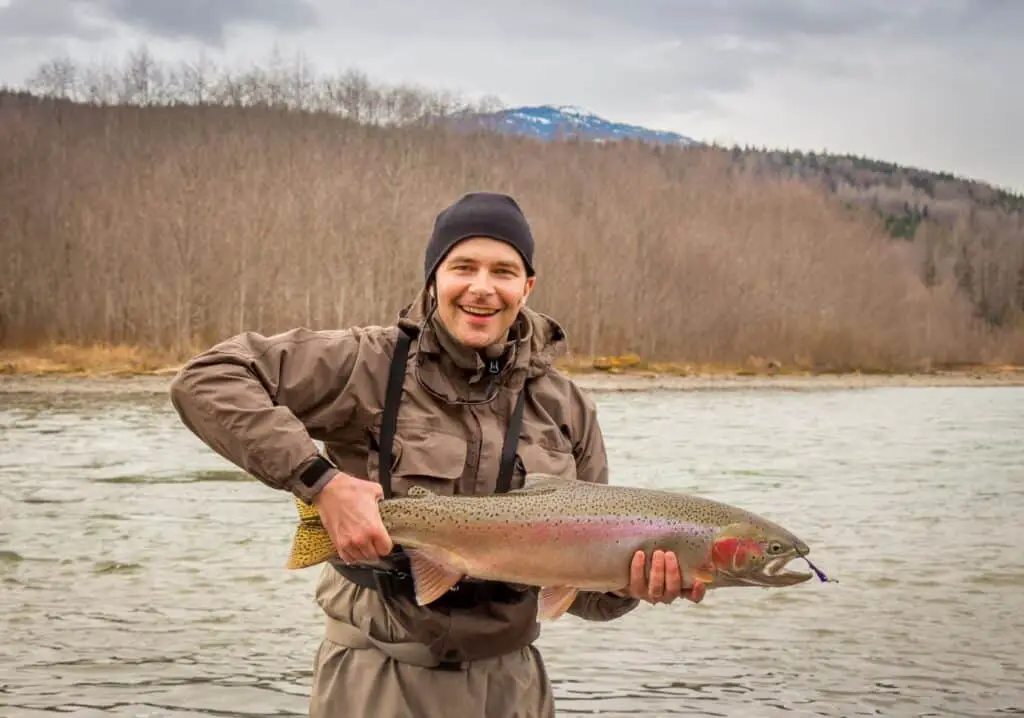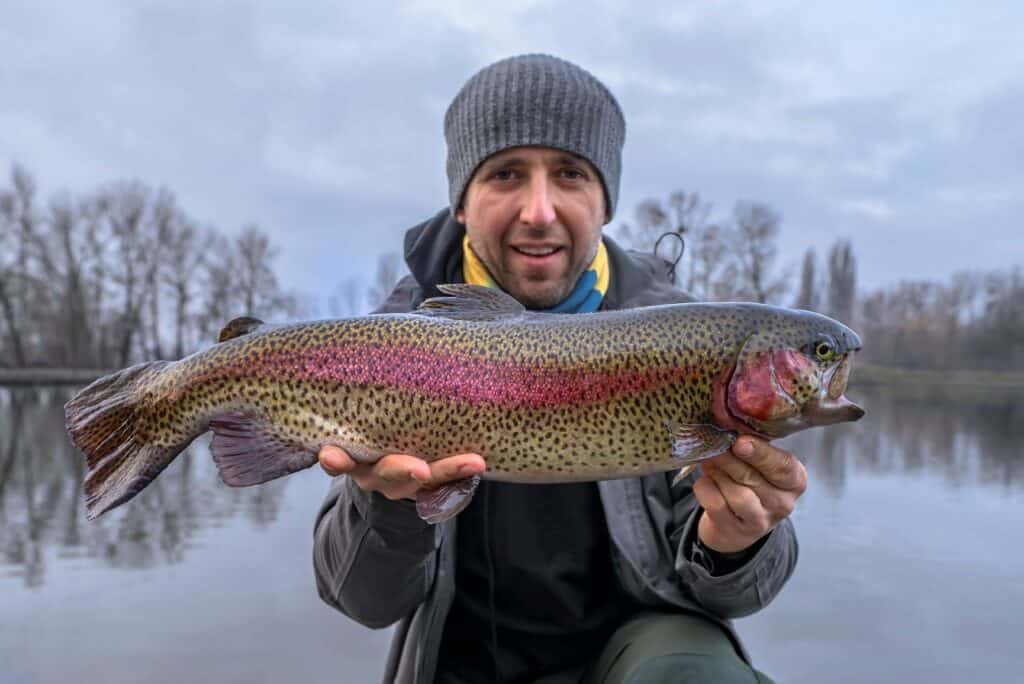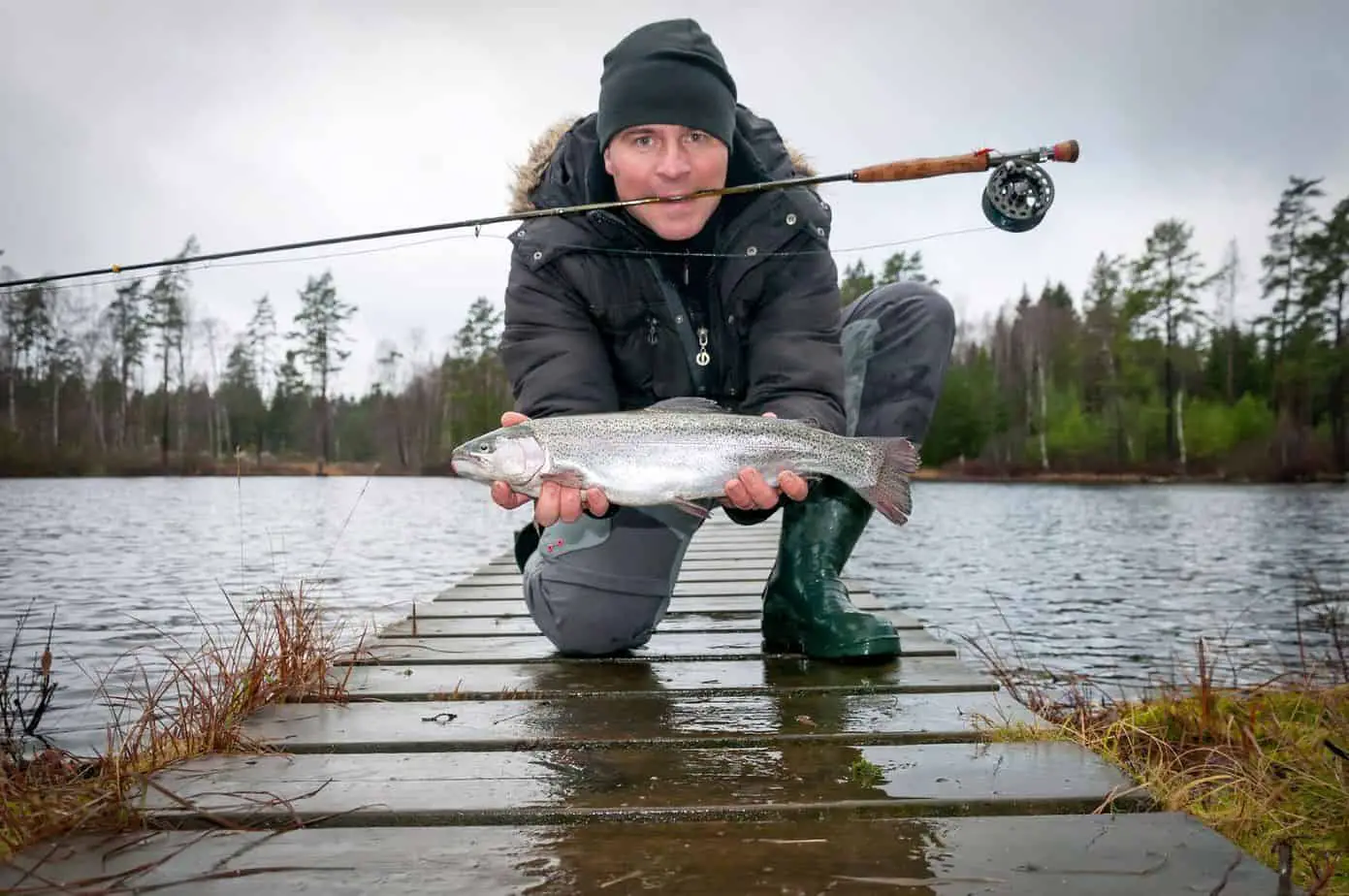This is perhaps one of the most frequently asked questions regarding separating members of the salmonid family. The answer isn’t quite as simple as you may think, and in answering it, we also discover some strange truths that make us ask if we haven’t been wrong about these fish all along.
So what is the difference between steelhead and rainbow trout?
The most obvious answer to the difference between steelhead and rainbow trout is that steelhead trout is merely the rainbow trout’s sea-going version. It is a trait that occurs across many other species of trout too. Sea-going brown trout are known as seatrout, but sea-going cutthroat trout are simply known as sea-going cutthroat trout!
So, is it as simple as that?
Well no. The real answer is more complicated. According to some people, recent DNA studies could mean reclassification of the entire species. This article will look at the standard definition and then dig a bit deeper into the salmonid family’s relationships.
Main Differences Between Steelhead Trout and Rainbow Trout
Rainbow and steelhead trout are the same species but with differing lifestyles, and this difference in lifestyle is the only fundamental separator between them. It does drive other differences, though, like spawning behavior and average size.
The table below is a comparison between the species.
| Rainbow Trout | Steelhead Trout | |
|---|---|---|
| World Record | 48lb | 36lb |
| Avg. Weight | Mature Fish 2lbs to 8lbs | Mature Fish 2lbs to 36lbs |
| Habitat | Fresh Water | Sea Water (Spawn in Freshwater) |
| Natural Range | Western North America | Western North America |
As you can see from the table, the largest fish caught between the two species is a rainbow trout, but this doesn’t give the full picture. Consider the average weight of the two fish. This figure more accurately describes the general size of the trout you’ll encounter. Steelhead are generally the larger of the two species, mainly due to the difference in diet. Although the record stands at 36lbs, fish of 55lbs have been noted but didn’t qualify for the record books.
Another difference between the two is their appearance. This is also largely attributed to their diet.
Rainbow Trout: – Rainbow trout are so-called because of their multi-colored hue. It is a silvery fish with a central band of pink-colored scales along both flanks. The top of the fish can be of various colors. Mostly they are tinged with green, blue, or yellow. It also has dark spots along its upper body.
Steelhead Trout: – As the name suggests, steelheads tend to be a silvery color. They can also be a coppery color on occasion. Their seagoing lifestyle is good for their figures as well. Steelheads tend to be slimmer and more streamlined than their freshwater brethren.

The Classification of Rainbow Trout and Steelhead Trout
I have spent most of my adult life with a fishing rod always close to hand, and one of my main prey has been rainbow trout. When lucky enough, I have also done a bit of steelhead angling. (There is actually some excellent steelhead fishing near me in northern Ohio) In angling terms, these species have been the backbone of my fishing life. However, just occasionally, I would have the luxury of a salmon fishing trip. It turns out that I may have been fishing for salmon all the time.
Let me explain. In researching this article, I discovered that recent DNA tests were done on rainbow and steelhead trout. They have shown to be closer related to salmon than trout (the same applies to cutthroat trout). I am no genealogist, so I won’t go into any depth as most of it went over my head. However, the gist of the study was that these trout would be more accurately placed in the salmon family, and some reclassification may be necessary.
Ultimately, while this is an interesting fact, they will always be known in the angling fraternity as trout. In the next sections, we will look at the individual species in greater depth, including discussing some of the most popular fishing methods for both species.
Additional Facts About Rainbow Trout
rainbow trout are many anglers’ favorite catch the world over. But its natural range is the lakes, streams, and rivers that lie to the west of the Rocky Mountains. This is where they truly flourish. Although they are now found worldwide, few countries outside the US that rainbows manage to breed successfully in the wild.
Rainbow Trout Lifestyle Facts and Spawning Behavior
On average, a mature fish will measure around 16” and weigh between 2lbs and 8lbs, although they can grow a lot larger, as mentioned. They are a tolerant species as far as water temperature goes, and although they are happiest in temperatures of between 55° and 70°. They will survive in water temperatures of between 32° and 70°.
As with most fish in the salmon family, they have a natural drive to return to the river where they hatched to spawn. When they are ready to spawn, a female will find a quiet and sheltered spot of water with a gravelly bottom and, using her tail, will dig a depression in the gravel. Known as a redd, she will lay her eggs in this depression.
Once she has made the nest, the female lays her eggs. There could be anywhere from 200 to 8,000 eggs. She then waits for a male to fertilize them, then she will cover the eggs with gravel to protect them, and both fish leave. It takes around three weeks for the eggs to hatch, only a few fish will survive into maturity. The temperature of the water is a critical factor in ensuring any of the eggs hatch. It is this variable that stops them from wild breeding in most other countries.
Diet
rainbow trout are predators and opportunistic feeders. They will eat almost anything, insects, fish eggs, including rainbow trout eggs, small fish, crustaceans, and even scavenge on other fish’ carcasses. Despite this, anglers will all tell you that when it suits them, they can be fussy.
Other Rainbow Trout Facts
Before discussing some of the fishing techniques and tips, let’s briefly look at some other rainbow trout facts.
- Interbreeding – Rainbows are classified as being in the genus of black-spotted trout. As such, they can interbreed with other species of the same genus.
- Spawning Season – rainbow trout spawn each spring; the species reaches sexual maturity around three or four years of age.
- Commercial Farming – rainbow trout have been farmed since the late 19th Century and are now farmed and stocked on every continent bar Antarctica. The biggest producer of farmed rainbow trout is Chile.
- Eating – Because of this widespread farming, chances are if you purchased trout from the supermarket, it was more than likely rainbow trout. Farmed meat is generally more orange in color than natural fish. In nature, the meat’s color depends on the fish’s diet and can vary from white to dark red.
- Predators – While they are a predator themselves, they are also often the prey. Apart from humans, rainbows are preyed upon by pike and muskie, birds of prey, cormorants, Heron, and even raccoons.
Additional Facts About Steelhead Trout
For many anglers, myself included, the very thought of a steelhead outing is enough to get the adrenalin pumping. Even though they are ‘only’ seagoing rainbow trout, there is something about fishing for these stunning fish that make it a magical experience. They are rarer than Rainbows, and generally, they are fitter too. In this section, we will cover some facts about steelhead Trout.
Steelhead Trout Lifestyle Facts and Spawning Behavior
As noted, steelhead and rainbows are classified as the same species. The differentiating factor is their lifestyle. Rainbow trout will spend their entire lives in freshwater, whereas steelhead trout will spend most of their lives at sea, returning to freshwater only to spawn.
Like salmon, it is normal for them to return to the very river of their birth to spawn. This behavioral trait is scientifically known as ‘anadromy.’ There is a big difference. However, between the species, whereas salmon return to spawn then die, steelhead trout can return to spawn more than once.
They have been recorded as living up to 11 years in the wild and can grow to be as large as 55lbs or possibly even 60lbs.
Diet
Adult steelheads have a varied diet that includes crustaceans, mollusks, fish eggs, smaller fish, insects, and larvae. Younger steelhead trout will generally feed on zooplankton until they are large enough to feed on larger prey.
Other Steelhead Trout Facts
- Change in Appearance – Before they spawn, they begin to look more like rainbow trout as the stripe on their side turns to a reddish-pink color.
- Distribution – The US Fish and Wildlife Service has recorded the species found throughout Washington, Oregon, California, and Alaska. Sadly, they also say they are considered an endangered species across much of their natural range.
- Sexual Maturity – The younger fish will generally live in the river of their birth for up to a year before heading out to sea. They will typically reach sexual maturity between two and three years old.

Different Fishing Tips and Techniques for Rainbow Trout and Steelhead Trout
Rainbow Trout Fishing Tips and Techniques
Rainbow trout fishing can be as easy or as complicated as you want it to be. A simple spinning rod and reel with some hooks and basic terminal tackle like floats and swivels is all you need to get started. Alternatively, a full fly-fishing setup with multiple lines, boxes of flies, waders, nets, rods, leaders, vests, and much more are how some people choose to tackle this fish. This is one reason why for many anglers, rainbow trout is a fantastic way to get into angling.
No matter how you approach this, there are a few tips that apply to whatever method you use.
- Best Time to Fish for rainbow trout – This can vary from water to water and region to region. However, mostly Spring and Fall are considered the best time to fish. The water is generally around the right temperature, and the fish are either feeding up for the winter or beginning to feed again after the winter.
- Read the Water – If there is a lot of surface activity, then the fish are likely feeding on hatching insects. You should tackle up to ensure whatever method you are using targets upper layers of the water. Conversely, if there isn’t much surface activity, then fish deeper.
- Tackle as Light as Possible – rainbow trout have excellent eyesight, and heavy lines will often spook them. To increase your chances, it is best to use as light a tackle rig as you can get away with. (This also adds to the excitement of the fight.)
- Vary your Methods – Just because a particular bait worked one day doesn’t mean it will work every day. Fly fishers will invariably try a multitude of flies and depths over the course of a day. For those using spinning gear, it is something that should also be tried. If your bait isn’t working, then try switching to spinners, plugs, or spoons.
- What bait and Flies to use – There are simply too many flies to begin to cover. However, a range of types of flies is essential. The trick is to try and match what the fish are feeding on. To do this, most fly anglers will carry a range of flies that include dry-flies for when the fish are surface feeding, nymphs, and lures that mimic small fry. For bait fishers, maggots and worms are always safe bets, as are many of the plastic baits, and a range of spinners and lures are essential in any tackle box.
Steelhead Trout Fishing Tips and Techniques
steelhead trout fishing can be challenging. They aren’t as prolific as rainbow trout, nor are they quite as eager to attach themselves to a hook. However, with some patience, luck, and a little knowledge, the result can be the fight of your life. In this section, we will cover some tips and techniques to help you catch that steelhead.
- Best Time to Fish for Steelhead – You can fish for steelhead the entire year-round, but there are optimum times that can vary wildly from river to river. As a guideline, springtime and Fall are considered the best times.
- Cover the Water – Trout anglers, mainly fly fishers, will generally try a few casts and move on. With steelhead, it is best to cover the entire expanse of the water you are fishing before considering moving. Steelheads can congregate in a particular spot of water.
- Look for Rocks – steelheads like to lie around large rocks; these are always a good spot to target.
- Try Different Methods – There are a variety of proven techniques that work for catching steelheads. Sometimes it is worth varying your method if one technique isn’t working. Successful methods include fly-fishing, lures and spinners, bait, trolling, and float fishing.
- Best Baits to Use – Many anglers consider fish eggs or artificial fish eggs to be the very best bait for steelheads. Other worthy baits include shrimp, minnows, and many plastic baits.
- Artificial Lures – These have been used successfully to catch steelhead for decades. There are now many ranges designed to target this species specifically. These include Shallow Divers, Acme Little Cleo’s, Yo-Zuri Pin’s Minnows, and Blue Fox Pixee Spoons.
- Best Time of Day to Fish for Steelhead Trout – Many anglers tout dawn and dusk as the best time to fish for steelhead. But in the right conditions, they can be caught right through the day. Many fly fishers swear that brighter is best as it allows them to see and target the fish.
- Local Knowledge – No matter what you are fishing for or whatever technique you are using, the best fishing tip ever applies. Get some local knowledge, local tackle shops, internet forums, local anglers are all fonts of information that can stop you thrashing away at a stretch of water known to be a dead area.
Conclusion
Rainbow trout and steelhead are amongst the most sought after catches by anglers across the whole USA. They are both aggressive fighters that make truly worthy opponents. I hope this article helped you appreciate these fish a little bit more. They are both fascinating creatures with fascinating and completely different lifestyles despite being the same species.
Science is also discovering some curious facts about these ‘trout’ that, at least at the scientific level, could change the way we think about them. However, regardless of what science says, as an angler, I’m genuinely appreciative of their beauty and strength.
If you find this article helpful, don’t leave without sighing up for our newsletter and checking out our Recommended Fly Fishing Gear List.
Don’t forget to check out our other Fish Guide articles.
- Are Bass Good To Eat?
- What’s the Difference Between Trout and Salmon?
- Are Bonefish Good To Eat?
- What’s the Difference Between Carp and Buffalo Fish?
- Are Pike Good To Eat?
- The 7 Best Secret Rainbow Trout Baits
- Best Powerbait For Stocked Trout
- What Is The Difference Between Walleye And Pickerel?
- What Is A Tiger Trout? Where to Find One and How To Catch One


